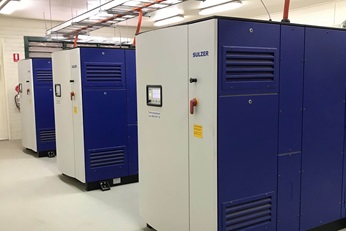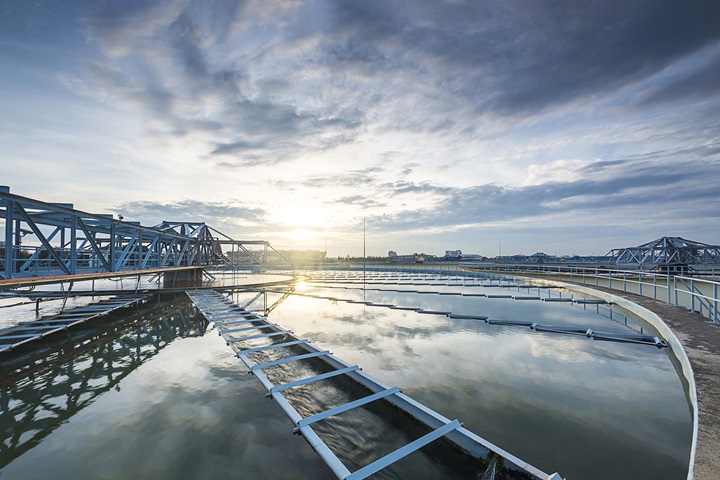HST turbocompressor for efficient aeration with low environmental impact
Turbocompressors boost treatment capacity and lower costs, noise and footprint
The challenge
Major capital works at BSWWTP are being implemented to meet the demand of an increasing population. It is anticipated that the plant will accommodate another 18’000 connections by 2035. Another challenge is to decrease the greenhouse gas emissions by 30%. The current capital upgrade projects will enable CHW to meet both challenges while being 100% compliant with environmental and regulatory requirements.
The Ballarat South plant was suffering from frequent breakdowns of the existing positive displacement blowers, affecting the aeration, which meant a serious challenge to meet EPA (Environment Protection Agency) regulatory requirements. The existing machines were also very inefficient and the noise was quite a nuisance, bringing complaints from the neighbourhood residents, some escalating to EPA.
The solution
One of the tasks was to increase the air capacity and identify the most efficient and reliable blowers available in the market. Once the power consumption, maintainence requirements, noise levels, footprint and life cycle cost of the HST were benchmarked against the existing blowers, it was easy to choose the HST. Based on the unpredictable population growth, Sulzer offered smaller machines that provide better turndown, system efficiency and also the flexibility to add another unit if the population would increase more than expected.
The next task was to install the additional aeration equipment. Due to the small footprint of the machines, it was quite easy to fit them into the same space as the existing blowers. Switchboard and electrical upgrades were made to accommodate the higher capacity of the blowers.
The HST turbocompressors were factory tested and then field tested. The results were heavily scrutinized due to the competitive situation. The turbocompressors passed all tests, showing that Sulzer delivers what is promised. The new blowers offer energy savings of approximately 30% compared to the existing positive displacement blowers.
Key performance requirements and tests met by the new blowers
- Ability to provide air flow within the required range without instability: The blowers met the required performance at an inlet air temperature of up to 35°C.
- The blowers are capable of operating without surge, shutdown or bearing damage at an inlet temperature of
50°C, though at reduced efficiency. - The new blowers meet the power consumption figures of the equipment data sheet.
Fawzi Saldin, Process Engineer - Ex Central Highlands Water (CHW)
The high-speed turbo blowers with magnetic bearing offered us greatly improved efficiency and reliability. The noise was reduced down to nearly 70 dBa in the blower room.
Customer benefit
- Dramatic increase in efficiency and improvement in reliability over old PD blowers
- Reduced footprint, noise and maintenance costs
- Nearly maintenance-free operation, reduced to replacing filters and backup batteries
- Sulzer's catalogue-claimed performance was achieved in site testing - more than 30% lower energy consumption compared to previous equipment
- Easy installation
- Less vibration
- The successful modernization resulted in an efficient treatment plant equipped for nitrogen and phosphorus removal
- HST technology with 100% air cooling, compact installation and active magnetic bearing control are key elements for Central Highlands Water
The HST 20 turbocompressor is an integrated package, designed for ease of installation and operation, with an inlet silencer, an outlet silencer and a silenced blow-off valve incorporated into the cabinet. Complexity is reduced, along with the cost of installation. The project was a retrofit so it was essential that the solution fitted well into the existing compressor room, making it easy to replace the old, inefficient machines.
Three HST turbocompressors
| Type | HST 20-6000-150 |
| Power | 150 kW |
| Flow rating | 2’500 – 7’000 Nm3/h |
| Pressure rating | 30 - 90 kPa |
| Quantity | 2 duty, 1 standby |
| Biological process | IDAL (Intermittently decanted aerated lagoon) |
| Maximum required flow | 5’500 Nm3/h (humid) |
| Maximum required pressure | 65 kPa |
| Minimum required flow | 2’700 Nm3/h (humid) |
| Minimum required pressure | 40 kPa |


